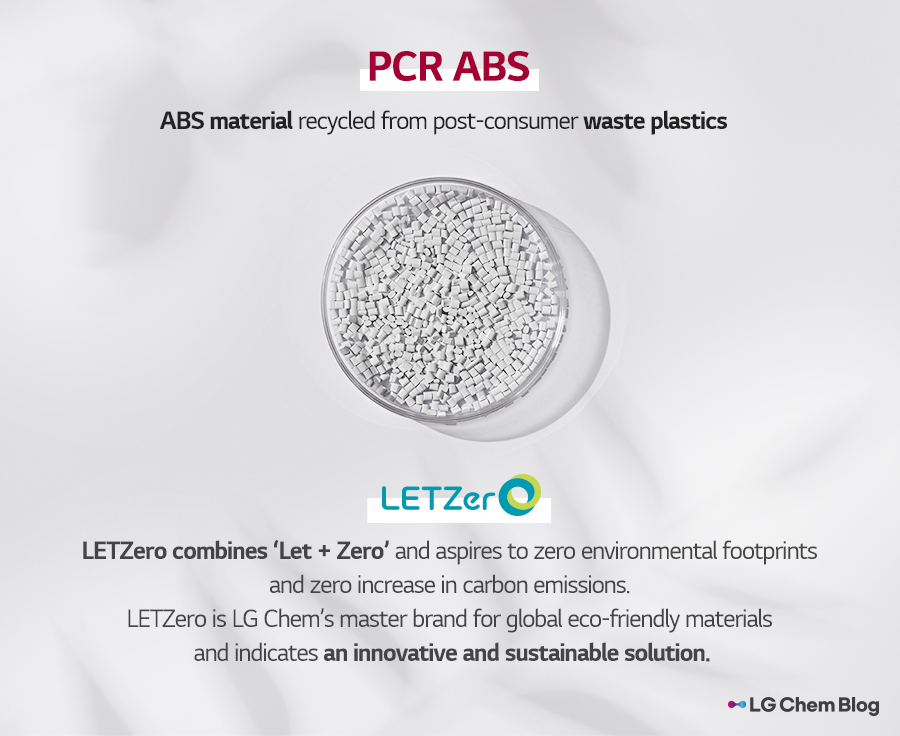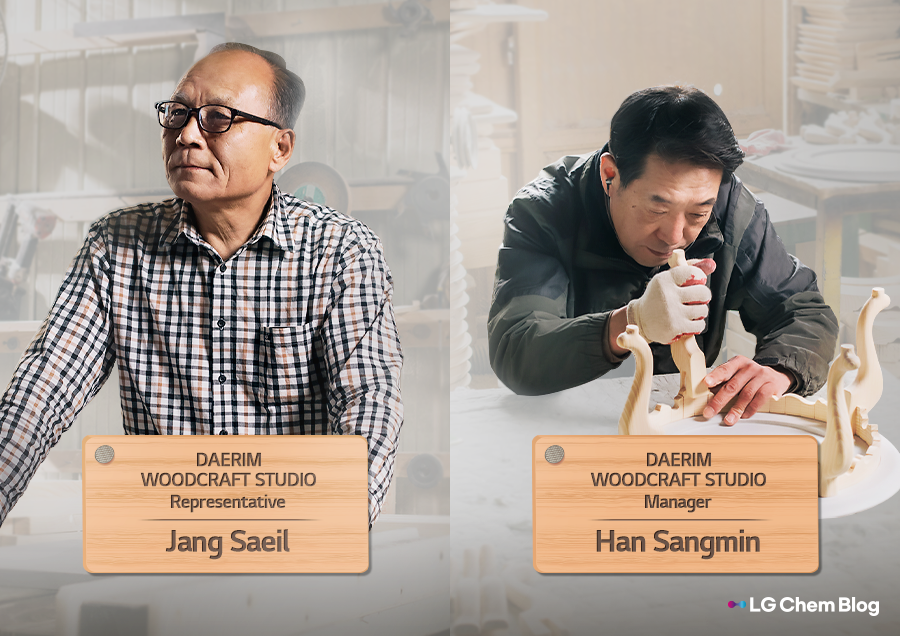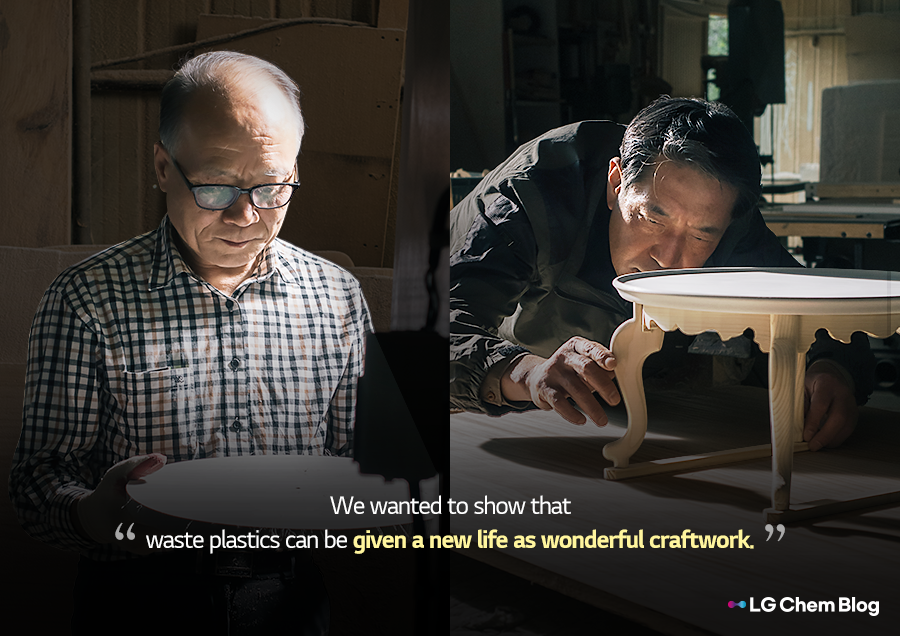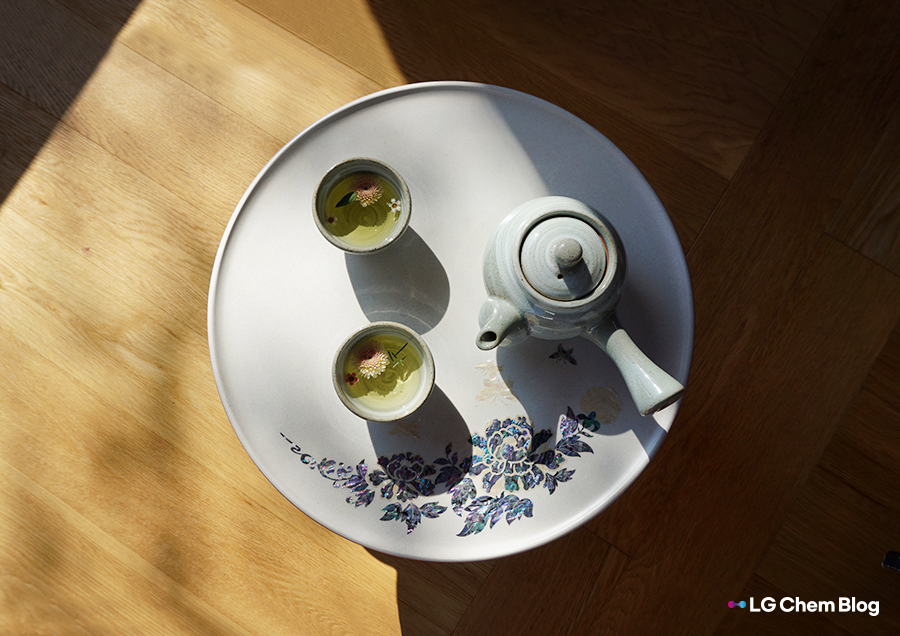Soban, Korea’s traditional craftwork, is given a new life with waste plastics. A behind story to our documentary
2023. 05. 01
2023. 05. 01
On November 19, 2021, we released a documentary <Soban Again> (Watch documentary) on our YouTube channel. The documentary follows a journey of PCR ABS, made of waste plastics, to show how it is recrafted into a soban, Korea’s traditional small portable tray. Master craftsmen of woodwork, expert of lacquerware inlaid with mother-of-pearl (najeonchilgi), and people who pioneer a market for waste plastics worked together for nearly a year, experimenting with new ideas and mounting challenges. Here we would like to share a behind story of the documentary. What kind of material is PCR ABS? And what made the experts of woodcraft, lacquerware, and waste plastics decide to participate in <Soban Again> project?
We have worked on a project to develop new plastic materials using waste plastics. In 2020, we produced PCR ABS (Read behind story), the first white recycled plastic to be developed in the chemical industry. PCR (Post-Consumer Recycled) indicates products recycled from post-consumer products. ABS (Acrylonitrile Butadiene Styrene) is a plastic material with excellent strength and thermal resistance, and it can be made in a wide range of colors.

In addition to PCR ABS, (1) eco-friendly materials such as PCR PC (Polycarbonate) and PCR PC/ABS, PCR PP (Polypropylene), (2) compostable materials that are decomposed in certain conditions, and (3) bio-circular balanced materials that replace part of materials with renewable materials were included in LETZero, which LG Chem launched in 2021 as an eco-friendly brand.
PCR ABS is made of waste plastics of various colors, and as such, it is easier to produce in dark colors, while making PCR ABS in white can be challenging. After vigorous research and experiments, we succeeded in making PCR ABS in white color. Upon hearing this news, a woodcraft studio in Daegu, Korea, contacted us, saying that they wanted to craft a soban using PCR ABS. In this short interview, they share a story of how they worked with PCR ABS to craft a soban.

PCR ABS is recycled from waste plastics. What made you interested in the material?
•Han: It was around in autumn 2020 that I began to hear a lot about the climate crisis and carbon neutrality in the media. I became interested, looked up related information, and realized that it was a serious problem. Then, plastic recycling caught my attention. I saw how recycled plastics are used to make plant pots, clothing, toothpaste squeezer, etc. I thought maybe we could do something too. How can we contribute to recycling materials? Then soban came to my mind. We manufacture lots of soban, and export them. Can we make soban with recycled plastics? By chance, I saw that LG Chem manufactures PCR ABS, and I posted a reply to LG Chem’s YouTube posting, saying that I work at Daelim Woodcraft Studio in Daegu, Korea, and we would like to use PCR ABS to craft soban. I didn’t expect to receive a reply, but LG Chem reached out to us, saying they wanted to work with us.
We heard there were many difficulties in making soban with PCR ABS.
•Jang • Han: As you know, PCR ABS looks like rice grains. We needed a board made of PCR ABS, but did not know whom to ask. It took months before we found The Fourth Space, which could make large boards with recycled plastics. We contacted The Fourth Space with LG Chem, and the project began to move forward. We heard that The Fourth Space had a difficult time manufacturing boards from PCR ABS. In the end, we got the board, and began to craft a soban.
There must have been trials-and-errors as you crafted a soban with waste plastics.
•Jang: I have been crafting soban for forty years(laugh). But this was the first time I used recycled plastics to make soban. We carve the top part of soban with a carving knife. It was difficult to do so with PCR ABS as it was very firm. Still, I thought it would make a strong soban with good water resistance. I also liked the idea of recycling waste plastics. This good feeling kept me moving. Some might think that wood craftsmen like us only work with wood and always make same products. It is not true. We take on new challenges all the time. We try new designs and work with new materials.

•Jang • Han: Maybe it is our wishful thinking, but we hope to introduce this soban in an upcycling competition, or even present at exhibitions like Maison Objet in Paris or a furniture exhibition in Italy. We want to show the world that Korea’s traditional craftworks are evolving. We hope that more people will be interested in soban. Soban is something that Korean people have used for a long time. It is not a historic relic, but a practical item used in daily life. The place for soban is our home, not behind a glass case in a museum. We hope that our project raises awareness about waste plastics, and people understand they can be used to manufacture wooden craftwork like soban. They are not merely wastes; they can be given a new life as wonderful products. This is our meager effort, and we hope it will have a butterfly effect and create a strong positive repercussion.
What kind of work do you do at The Fourth Space?
•Lee Hyewon: I always say that the vision of The Fourth Space is to find value in the seemingly useless. Since December 2019, we have been focusing on upcycling plastics. We are the first in the country to manufacture 2cm thick plastic sheets in the size of 1,000mm by 1,000mm. When I worked at a company in 2018, I had a side project, and dabbled in various areas. Then I came to know Precious Plastic (A Europe-based global community for plastic upcycling and now renamed to One Army). At the time, upcycling was an unfamiliar concept in Korea, and I was shocked to see the advanced upcycling markets in other countries. Since then I planned upcycling projects, and then rented an office in 2019 to launch on plastic recycling. That is how The Fourth Space came to be.
We heard there were many difficulties in manufacturing sheets from PCR ABS.
•Lee: The hardest part was to decide on initial setting values to extract sheets from PCR ABS. Plastics are made of various materials that have different melting points and flowing properties. Particularly, it is hard to obtain accurate data points from PCR plastics because they are not homogeneous. Compared to PE, PP, and PS that we used before, ABS is firmer and hardly flows. Also, more bubbles appear. We made about ten attempts to manufacture sheets. Each time it takes four hours to dry and two hours to press, so in total, it took about 60 hours. Plus, sanding work, and it took several months (laugh). We needed a spirit of challenge and lots of data to overcome our difficulties. We modified variables after each test. Many people tried to stop us, saying that we can’t make sheets from ABS. Still, I saw that with each test, the quality of the sheet improved. I felt confident that we could do it.
Do you have a message you want to communicate through this soban?
•Lee: I want people to know that upcycling can do more than producing small molded products, and also that bottle caps are not the only plastic materials that can be recycled. I want to show that waste plastics can be recycled to produce high-quality products that can even replace marble and wood slabs, and set precedents for other studios.

This soban was born from many people’s efforts and attempts. Made of PCR ABS recycled from waste plastics, the soban became a work of art after applying lacquerware and decorating with mother-of-pearl. This small craftwork contains meaningful messages and the hopes of the people who worked on it. They include a hope to help the environment, a hope that soban would stay with us for a long time, and a pride that waste plastics can be used to craft high-quality products, and a wish that more and more people would be interested in upcycling. LG Chem joins hands in this endeavor, and we hope that our readers would also support our efforts.

There are no comments yet! Be the first to let us know your thoughts!